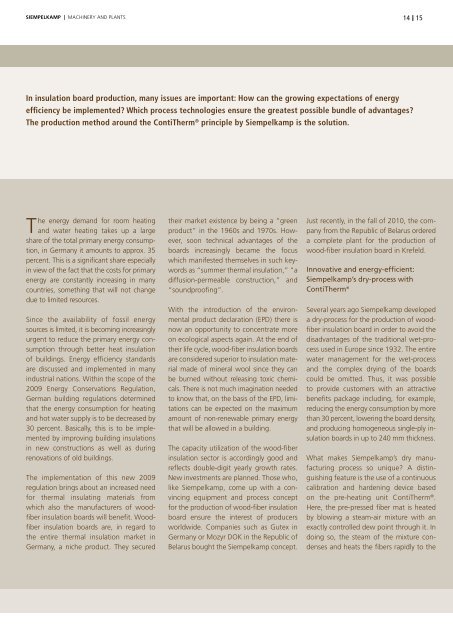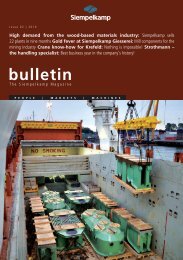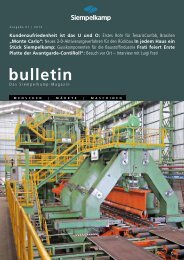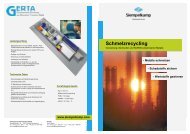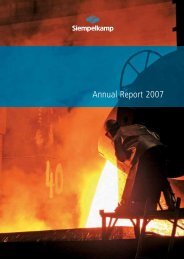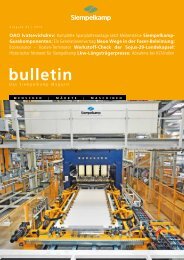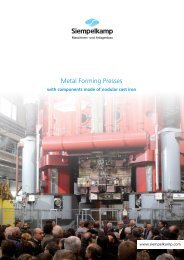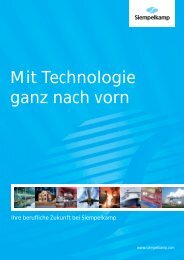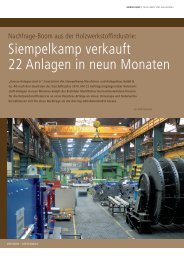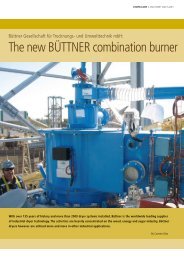Bulletin 1/2011 - Siempelkamp
Bulletin 1/2011 - Siempelkamp
Bulletin 1/2011 - Siempelkamp
Create successful ePaper yourself
Turn your PDF publications into a flip-book with our unique Google optimized e-Paper software.
SieMpelkaMp | MACHInERy AnD PLAntS<br />
In insulation board production, many issues are important: How can the growing expectations of energy<br />
efficiency be implemented? Which process technologies ensure the greatest possible bundle of advantages?<br />
The production method around the ContiTherm ® principle by <strong>Siempelkamp</strong> is the solution.<br />
the energy demand for room heating<br />
and water heating takes up a large<br />
share of the total primary energy con sumption,<br />
in Germany it amounts to approx. 35<br />
percent. this is a significant share especially<br />
in view of the fact that the costs for primary<br />
energy are constantly increasing in many<br />
countries, something that will not change<br />
due to limited re sources.<br />
Since the availability of fossil energy<br />
sources is limited, it is becoming increasingly<br />
urgent to reduce the primary energy consumption<br />
through better heat insulation<br />
of buildings. Energy efficiency standards<br />
are discussed and implemented in many<br />
industrial nations. Within the scope of the<br />
2009 Energy Conservations Regulation,<br />
German building regulations determined<br />
that the energy consumption for heating<br />
and hot water supply is to be decreased by<br />
30 percent. Basically, this is to be im plemented<br />
by improving building insulations<br />
in new constructions as well as during<br />
renovations of old buildings.<br />
the implementation of this new 2009<br />
regulation brings about an increased need<br />
for thermal insulating materials from<br />
which also the manufacturers of wood-<br />
fiber insulation boards will benefit. Woodfiber<br />
insulation boards are, in regard to<br />
the entire thermal insulation market in<br />
Germany, a niche product. they secured<br />
their market existence by being a “green<br />
product” in the 1960s and 1970s. However,<br />
soon technical advantages of the<br />
boards increasingly became the focus<br />
which manifested themselves in such keywords<br />
as “summer thermal insulation,” “a<br />
diffusion-permeable construction,” and<br />
“soundproofing”.<br />
With the introduction of the environmental<br />
product declaration (EPD) there is<br />
now an opportunity to concentrate more<br />
on ecological aspects again. At the end of<br />
their life cycle, wood-fiber insulation boards<br />
are considered superior to insula tion material<br />
made of mineral wool since they can<br />
be burned without releasing toxic chemicals.<br />
there is not much imagination needed<br />
to know that, on the basis of the EPD, limitations<br />
can be expected on the maxi mum<br />
amount of non-renewable pri mary energy<br />
that will be allowed in a building.<br />
the capacity utilization of the wood-fiber<br />
insulation sector is accordingly good and<br />
reflects double-digit yearly growth rates.<br />
new investments are planned. those who,<br />
like <strong>Siempelkamp</strong>, come up with a convincing<br />
equipment and process concept<br />
for the production of wood-fiber insula tion<br />
board ensure the interest of producers<br />
worldwide. Companies such as Gutex in<br />
Germany or Mozyr DOK in the Republic of<br />
Belarus bought the <strong>Siempelkamp</strong> concept.<br />
14<br />
15<br />
Just recently, in the fall of 2010, the company<br />
from the Republic of Belarus ordered<br />
a complete plant for the production of<br />
wood-fiber insulation board in Krefeld.<br />
Innovative and energy-efficient:<br />
<strong>Siempelkamp</strong>’s dry-process with<br />
ContiTherm®<br />
Several years ago <strong>Siempelkamp</strong> developed<br />
a dry-process for the production of woodfiber<br />
insulation board in order to avoid the<br />
disadvantages of the traditional wet-process<br />
used in Europe since 1932. the entire<br />
water management for the wet-process<br />
and the complex drying of the boards<br />
could be omitted. thus, it was possible<br />
to provide customers with an attractive<br />
benefits package including, for example,<br />
reducing the energy consumption by more<br />
than 30 percent, lowering the board density,<br />
and producing homogeneous single-ply insulation<br />
boards in up to 240 mm thickness.<br />
What makes <strong>Siempelkamp</strong>’s dry manufacturing<br />
process so unique? A distinguishing<br />
feature is the use of a continuous<br />
calibration and hardening device based<br />
on the pre-heating unit Contitherm ® .<br />
Here, the pre-pressed fiber mat is heated<br />
by blowing a steam-air mixture with an<br />
exactly controlled dew point through it. In<br />
doing so, the steam of the mixture condenses<br />
and heats the fibers rapidly to the


